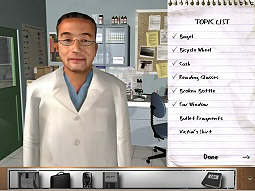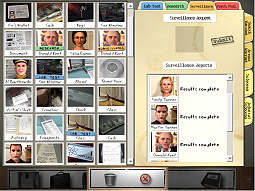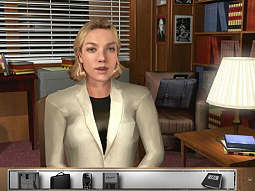|
Law & Order II: Double or Nothing
 Based on the popular television series, and featuring the voices and visages of some of the TV characters themselves, this is the second instalment of what may well be many more Law & Order games. I did not play the first, Dead on the Money, but on the strength of this episode I would play a third.
I confess I am not a watcher of the TV series, but that is more a product of the small amount of television I watch (I have to play all these games sometime) than any dislike of the show. I have seen a few episodes, and whilst I tend to find them a tad superficial, that again is more a product of my preference for a meaty 6 part series. All you should really take from this is the fact that what follows is not coloured by a devotion to the show or its characters, nor do I suffer from over-exposure. Based on the popular television series, and featuring the voices and visages of some of the TV characters themselves, this is the second instalment of what may well be many more Law & Order games. I did not play the first, Dead on the Money, but on the strength of this episode I would play a third.
I confess I am not a watcher of the TV series, but that is more a product of the small amount of television I watch (I have to play all these games sometime) than any dislike of the show. I have seen a few episodes, and whilst I tend to find them a tad superficial, that again is more a product of my preference for a meaty 6 part series. All you should really take from this is the fact that what follows is not coloured by a devotion to the show or its characters, nor do I suffer from over-exposure.
The game follows the structure of the show. You are first involved in a detective investigation, the goal of which is to arrest a suspect for trial. Then you have to conduct the trial, the aim of which is, of course, a guilty verdict. Despite these two discrete components, there is opportunity, and indeed necessity, for some further investigation during the trial.
The crime is murder, the suspects are several, the motive possibly one of many, and the underlying story quite a strong one. To get a successful jury verdict you will have to winkle and wend your way through all of this.
The game play revolves around the collection of possible evidence and the interviewing of all manner of individuals. What you ask these individuals and what you do with the evidence will determine your progress through the game.
Simply collecting stuff is not enough. You might submit material to the crime lab for analysis, or send it to records and research to see what they can find out. When the tests or research is ready, you will receive a call on your mobile phone telling you to come and get the results. Similarly, the people you meet can be put under surveillance, or even psychologically evaluated. The results of all this might reveal new leads or new locations to investigate.
So too questioning people is not just about asking every question in a permanently available dialogue tree. Several questions will be offered, and the wrong question may abruptly end the interview, or elicit no meaningful information. Too many meaningless questions might also terminate the interview. You need to give some thought to what you ask.
Having said that, after every interview you are given the option to conduct it again. As well, you might be given more than one option to ask a question in an interview. So making fatal mistakes is minimised, provided you learn from your questioning. However once you have accepted the outcome of interview, you may find that subsequent interviews are not so readily available.
Accepting the interview will mean it is logged in your case file, along with everything else you learn and discover. This is where you manage your case, and it is the hub of your progress. Everything you collect or learn takes up space, as does each person you interview. For example, if you choose to pick up an item you find, it takes up a slot in your case file. Send it for analysis and also down to research, and if you believe the outcome is important to your case, the results will take up two more slots. Interview a person and then accept a surveillance report on them, and you have used two more slots. You have 84 slots in all, which is a lot, but I had to delete items more than once before finishing. Items of no value are the ones to get rid of, but once gone, they can never be retrieved.
 The case file is also where you obtain search and arrest warrants, and issue your subpoenas for trial. You must submit the evidence you believe shows probable cause, and if successful, your warrants will issue. Without a warrant, you may not even get access to a location, or you may find evidence thrown out by the judge at trial.
If you haven't provided the right or sufficient evidence, your warrant will be denied. You can try again though, and accessing the relevant part of your case file will give you some feedback on the evidence you used. Persistence should pay off, provided you have in fact elicited the necessary information or evidence.
Before moving on, I must say that the case file mechanics are quite simple for something so detailed. What sounds complex is managed in a way that should make even novice players feel at home.
The game itself is not that difficult. As well as those aspects described, The District Attorney and your Squad Commander will occasionally phone with a suggestion, and your detective partner may well provide insightful comments as you play (he comes with you when you investigate). So despite the fact that you can apparently fail to investigate sufficiently to obtain an arrest, and also fail to get a guilty verdict, I struck neither of these things and did not need a walkthrough at any stage. I did, though, go carefully and methodically, I did collect a lot of ultimately useless material which I rejected after analysis, and I did think about my questioning, in both stages of the game. I also had to re-interview a couple of times, was sent back by the Commander to look again at one location, and never felt completely certain that there wasn't something I missed. I think experienced and novice players alike will be well served.
There is one other aspect which affects difficulty. At the start of each part, you choose two of four available character strengths to help you. I started by choosing teamwork and evidence collection. The latter gave me a cursor which reacted to hotspots when there was something I could examine or collect. It didn't only react to important items, and I collected far more useless than meaningful items, but it did mean I didn't have to click on every part of every scene. Given the amount of detail in the scenes, this strength is in my opinion, virtually compulsory.
Teamwork meant additional clues appeared on a blackboard or by fax, and I actually stopped reading these as they were too overt. The other strengths are case organisation, which will enable you to click on a hint button in the case file when assembling material for warrants or subpoenas, and interviewing/questioning, which limits the number of unhelpful question options.
You must choose two, and if you want a more challenging outing, I suggest you choose evidence gathering and either teamwork or case management, and simply don't access the extra hints. If you want an unguided click fest, then don't choose evidence gathering, and the difficulty will likely skyrocket. The case file is also where you obtain search and arrest warrants, and issue your subpoenas for trial. You must submit the evidence you believe shows probable cause, and if successful, your warrants will issue. Without a warrant, you may not even get access to a location, or you may find evidence thrown out by the judge at trial.
If you haven't provided the right or sufficient evidence, your warrant will be denied. You can try again though, and accessing the relevant part of your case file will give you some feedback on the evidence you used. Persistence should pay off, provided you have in fact elicited the necessary information or evidence.
Before moving on, I must say that the case file mechanics are quite simple for something so detailed. What sounds complex is managed in a way that should make even novice players feel at home.
The game itself is not that difficult. As well as those aspects described, The District Attorney and your Squad Commander will occasionally phone with a suggestion, and your detective partner may well provide insightful comments as you play (he comes with you when you investigate). So despite the fact that you can apparently fail to investigate sufficiently to obtain an arrest, and also fail to get a guilty verdict, I struck neither of these things and did not need a walkthrough at any stage. I did, though, go carefully and methodically, I did collect a lot of ultimately useless material which I rejected after analysis, and I did think about my questioning, in both stages of the game. I also had to re-interview a couple of times, was sent back by the Commander to look again at one location, and never felt completely certain that there wasn't something I missed. I think experienced and novice players alike will be well served.
There is one other aspect which affects difficulty. At the start of each part, you choose two of four available character strengths to help you. I started by choosing teamwork and evidence collection. The latter gave me a cursor which reacted to hotspots when there was something I could examine or collect. It didn't only react to important items, and I collected far more useless than meaningful items, but it did mean I didn't have to click on every part of every scene. Given the amount of detail in the scenes, this strength is in my opinion, virtually compulsory.
Teamwork meant additional clues appeared on a blackboard or by fax, and I actually stopped reading these as they were too overt. The other strengths are case organisation, which will enable you to click on a hint button in the case file when assembling material for warrants or subpoenas, and interviewing/questioning, which limits the number of unhelpful question options.
You must choose two, and if you want a more challenging outing, I suggest you choose evidence gathering and either teamwork or case management, and simply don't access the extra hints. If you want an unguided click fest, then don't choose evidence gathering, and the difficulty will likely skyrocket.
 At times, you will have to use an item or piece of information you have found to get an uncooperative witness to open up, or perhaps to enter a locked door. On those occasions your case file will open automatically and you simply click on the desired item. If you are correct, the witness will talk or the door will open. Of course, you may not have the right item.
There are a few traditional puzzles, again not too difficult although the encrypted e-mail took me some considerable time to decipher.
You will also get the opportunity to object to questions asked by the Defence Attorney at the trial, and sustained objections will help your case. He can also object to your questions. Usually the Judge will rule, but twice I was asked to rebut or explain myself further. You can brush up on the rules of evidence and such on the computer in the DA's office. At times, you will have to use an item or piece of information you have found to get an uncooperative witness to open up, or perhaps to enter a locked door. On those occasions your case file will open automatically and you simply click on the desired item. If you are correct, the witness will talk or the door will open. Of course, you may not have the right item.
There are a few traditional puzzles, again not too difficult although the encrypted e-mail took me some considerable time to decipher.
You will also get the opportunity to object to questions asked by the Defence Attorney at the trial, and sustained objections will help your case. He can also object to your questions. Usually the Judge will rule, but twice I was asked to rebut or explain myself further. You can brush up on the rules of evidence and such on the computer in the DA's office.
The graphics look good and the voice acting is of a high standard. The 3D character modelling is also fairly high quality. Movement is natural and facial expressions realistic, and the lead characters do indeed look like their real life counterparts. Apart from the characters, there is not a lot of motion in the scenes, but it is well used, as is the situational music and background sound.
Each screen is a discrete scene or location, but you have 360 degree panning as well as up and down, with the cursor fixed to the centre of the screen. In a very small number of scenes you can move forward to examine another room or area. At the bottom of the screen are icons for your phone (it will flash if a message is received), your case file, a map through which you access locations and witnesses (and which will be added to as you play), and the main menu. Right click or hit the space bar to access the icons. There is also a logbook which records absolutely everything. Combined with the fact that clicking on any of the things in your case file will enable you to review what you know about it or them, note taking is entirely redundant.
Double or Nothing took about 8-10 hours. I received 95% for my detective skills and 100% for my trial skills. I have no idea where the extra 5% went. It ran without incident, save for a single lock-up and one corrupted save file. There is a lot of blank screen time though as each screen loads - short each time but lots overall. It comes on 2 CDs, but once installed you only need the second.
You can choose detective and lawyer tutorials from the menu screen to help get you started, but the game itself will provide a little pop-up message when some aspect of game play occurs for the first time. There are 15 save slots, which is plenty. You can turn the background sound and music off, and you can play with subtitles. You can tweak the settings slightly if you have an older machine, and you can choose to play in small or full screen mode. If you choose the latter, the game will restore your normal resolution automatically.
I enjoyed Law & Order II: Double or Nothing. It's a bit different, not too taxing, well written and presented; hard to complain really.
Copyright © Steve Ramsey 2003.
All rights reserved.
System Requirements:
Windows 98/2000/ME/XP, Pentium III 500 MHz, 96 MB RAM, 650 MB disc space, DirectX 7 (included on disc), Quicktime 6, DirectX 7 compatible 16 MB video card, DirectX 7 compatible sound card.
|

